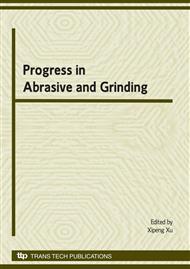[1]
M. Quirk and J. Serda: Semiconductor Manufacturing Technology, Chap. 4 (Pearson Education International, Columbus, Ohio, 2001), pp.67-90.
Google Scholar
[2]
I.D. Marinescu, A. Shoutak and C.E. Spanu: Abrasives Magazine, Vol. Dec-Jan (2002), pp.5-9.
Google Scholar
[3]
M. Naselaris: Proceedings of the SPIE, Vol. TD03 (2005), pp.118-120.
Google Scholar
[4]
J.A. Dudley: Microelectronic Manufacturing and Testing, Vol. 9 (1986) No. 4, pp.1-6.
Google Scholar
[5]
U. Heisel and J. Avroutine: CIRP Annals, Vol. 50 (2001) No. 1, pp.229-232.
Google Scholar
[6]
B. Li, X. Guo and Y. Liu: Semiconductor Technology, Vol. 30 (2005) No. 9, pp.57-60.
Google Scholar
[7]
Z. Wang, Y. L Wu and Y.F. Dai: Applied Optics, Vol. 47 (2008) No. 10, pp.1417-1426.
Google Scholar
[8]
M.K. Othman, A. Dolah, N.A. Omar and M.R. Yahya: IEEE International Conference on Semiconductor Electronics (2006), pp.583-585.
Google Scholar
[9]
E. Prochnow and D. F. Edwards: Applied Optics, Vol. 25 (1986), pp.2639-2640.
Google Scholar
[10]
K.Q. Wang: Lapping/Polishing Machine for Optical Parts and its Application in Lapping/ Polishing Sapphire Wafers, CN Patent 1, 546, 283, (2003).
Google Scholar
[11]
M.S. Bawa, E.F. Petro and H.M. Grimes: Semiconductor International, Vol. 18 (1995), pp.115-118.
Google Scholar
[12]
T. Fukami, H. Masumura, K. Suzuki and H. Kudo: Method of Manufacturing Semiconductor Mirror Wafers, European Patent Application EP0782179A2, (1997).
Google Scholar
[13]
Z.J. Pei, S.R. Billingsley and S. Miura: International Journal of Machine Tools and Manufacture, Vol. 39 (1999), pp.1103-1116.
DOI: 10.1016/s0890-6955(98)00079-0
Google Scholar
[14]
G.J. Pietsch and M. Kerstan: Simultaneous Double-disk Grinding Machining Process for Flat, Low-damage and Material-saving Silicon Wafer Substrate Manufacturing, Proceeding of the 2nd Euspen International Conference, Turin, Italy, (2001).
Google Scholar
[15]
S. Wolf and R.N. Tauber: Silicon Processing for the VLSI Era, Process Technology, Vol. 1 (Lattice Press, Sunset Beach, CA 2000).
Google Scholar
[16]
R. Vandamme, Y. Xin and Z.J. Pei: Method of Processing Semiconductor Wafers, US Patent 6, 114, 245, (2000).
Google Scholar


